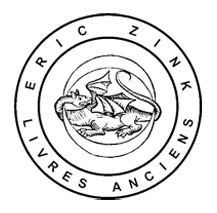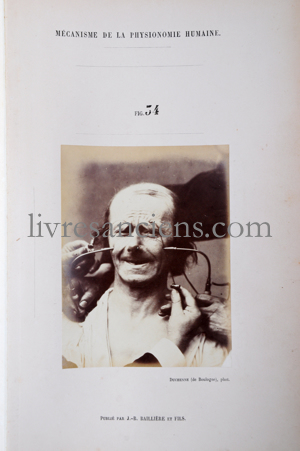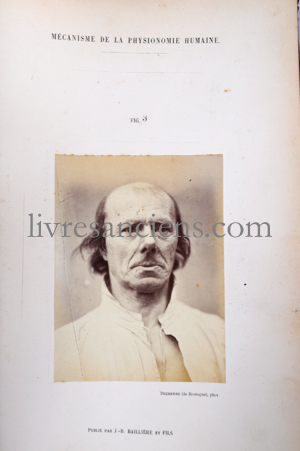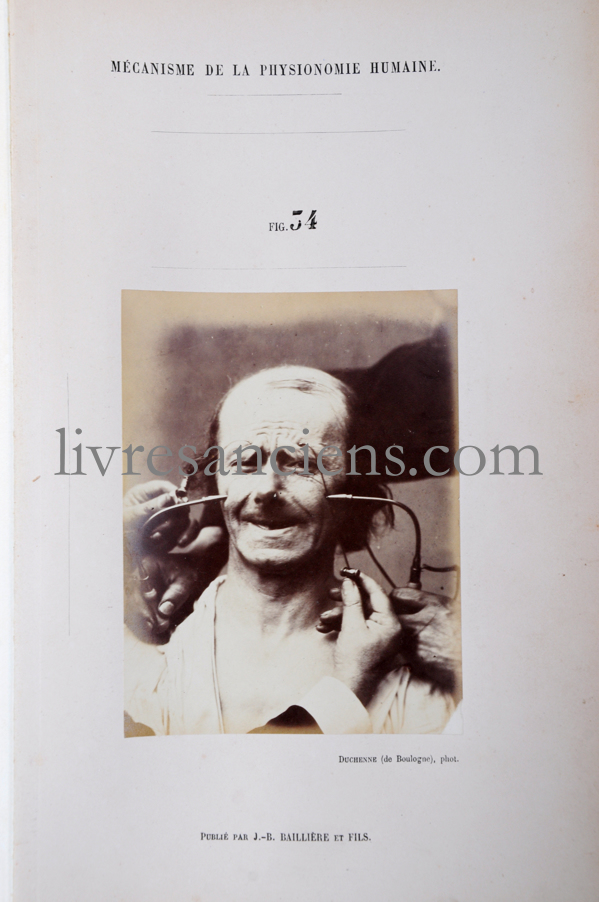

DUCHENNE, Mécanisme de la physionomie humaine, 1876

DUCHENNE, Guillaume-Benjamin.
Mécanisme de la physionomie humaine ou analyse électro-physiologique de l’expression des passions.
Paris, Baillière, 1876.
Two large 8vo (273x177 mm), Text : xii-[v] à xi-(1 bl.)-67-(1 bl.)-196 pages. Atlas : (4) pages, frontispiece, 9 plates with the 144 figures featuring the portaicts of the 82 subjects, some repeated to show only one half of the face with a different expression, and 82 large-format photographic plates (one per subject), numbered 3 to 84, figures 1 and 2 being sketches in text. binding : Full publisher cloth. Binding slightly faded, atlas curved.

Rare copy of the deluxe edition of the second edition with the atlas.
It's the first medical book illustrated with photographs of living subjects.
The celebrated work by Duchenne de Boulogne on facial expressions induced by electrification.
Duchenne de Boulogne’s research was intended both for anatomists and scientists (Darwin would later use Duchenne’s findings in his The Expression of the Emotions in Man and Animals) and for artists, who, as he said, “have not always been able to find the fundamental lines” of an expressive face.
Using his electrodes and induction coil, Duchenne assigned the precise role of each facial muscle in animating the human face.
He thus aimed to “make known, through electro-physiological analysis and with the help of photography, the art of accurately painting the expressive lines of the human face—a kind of orthography of physiognomy in motion” (from the preface).
A copy from the deluxe edition, issued by the publisher, accompanied by its atlas; the regular edition contained only the frontispiece and the nine plates in the text volume.
Our copy is complete with its atlas of 82 additional plates (the last eleven "aesthetic" plates are often missing).
The atlas reproduces the original photographs, whose portraits had been extracted to create the nine synoptic plates, now printed in large format on albumen paper and mounted.
The electrically induced emotions of the six models literally leap off the page.
The first series of experimental photographs (plates 3–73), featuring an old cobbler with a wrinkled face, was deemed too coarse when Duchenne first presented it. He was persuaded to create a second series (plates 74–84) showing young women in various poses—ecstatic to imitate Saint Teresa or cruel to mimic Lady Macbeth.
“Striving to satisfy those with a sense of beauty, and wishing to please while instructing, I have undertaken some new electrophysiological studies in which, as far as possible, I hope to meet the principal requirements of aesthetics: beauty of form, combined with the truth of facial expression, attitude, and gesture.” (p. 133)
He called this part of his work the aesthetic section.
Perhaps unconvinced of its scientific value, he did not always distribute these 11 “aesthetic” photographs with the atlas; for example, the copies sent to Darwin and Charcot stop at plate 73.
The publisher himself only anounced on the title page 74 plates. Copies with plates 74 to 84 are rare.
Duchenne stands at the crossroads of three recent scientific revolutions (electrical induction, physiology, and photography), yet here he has composed one of the true photographic masterpieces of the 19th century.
references: Garisson-Morton [4973, ed. 1862 : "Duchenne studied the mechanism of facial expression during emotion; his atlas of photographs was the first medical book illustrated with photographs of living subjects."], Jean-François Debord ["L'Âme au corps", 1993 : "Plus encore que des règles qui permettraient d'empêcher ou de modérer les écarts de l'imagination, c'est l'originalité de sa démarche qui fait aujourd'hui encore le succès de Duchenne auprès de certains jeunes artistes, étudiants à l'Ecole des beaux arts"].
Price : 18000 €


























